Seasonic G-Series 450W PSU Review
Seasonic's G series consists of reliable, high-performance PSUs. Today, we're reviewing the G-450 with 450W capacity, which features a semi-modular cabling design.
Why you can trust Tom's Hardware
Transient Response Tests
Advanced Transient Response Tests
For details on our transient response testing, please click here.
In these tests, we monitored the response of the PSU in two different scenarios. First, a transient load (10A at +12V, 5A at 5V, 5A at 3.3V and 0.5A at 5VSB) was applied to the PSU for 200ms while the PSU was working at 20 percent load. In the second scenario, the PSU was hit by the same transient load while operating at 50 percent load. In both tests, we used our oscilloscope to measure the voltage drops caused by the transient load. The voltages should have remained within the ATX specification's regulation limits.
These tests are crucial because they simulate the transient loads a PSU is likely to face (such as when booting a RAID array or handling an instant 100 percent load of CPU/GPUs). We call these tests "Advanced Transient-Response Tests," and they are designed to be very tough to master, especially for a PSU with a capacity of less than 500W.
Advanced Transient Response at 20 Percent
| Voltage | Before | After | Change | Pass/Fail |
|---|---|---|---|---|
| 12V | 12.184V | 12.062V | 1.00% | Pass |
| 5V | 5.063V | 4.933V | 2.57% | Pass |
| 3.3V | 3.339V | 3.212V | 3.80% | Pass |
| 5VSB | 4.998V | 4.969V | 0.58% | Pass |
Advanced Transient Response at 50 Percent
| Voltage | Before | After | Change | Pass/Fail |
|---|---|---|---|---|
| 12V | 12.130V | 11.997V | 1.10% | Pass |
| 5V | 5.035V | 4.912V | 2.44% | Pass |
| 3.3V | 3.310V | 3.182V | 3.87% | Pass |
| 5VSB | 4.965V | 4.932V | 0.66% | Pass |
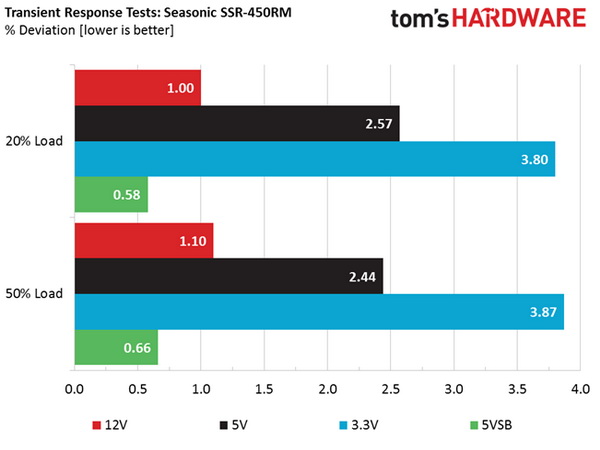
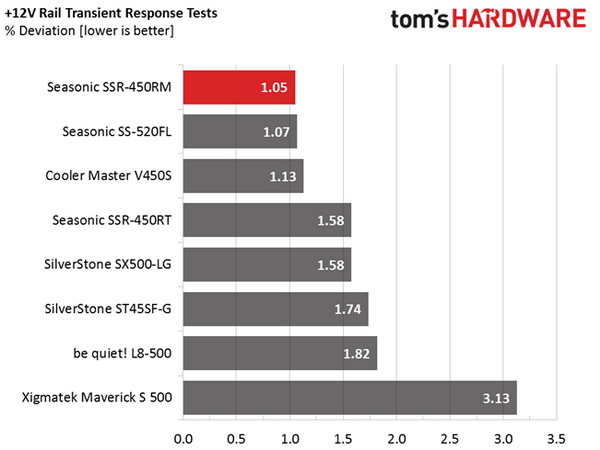
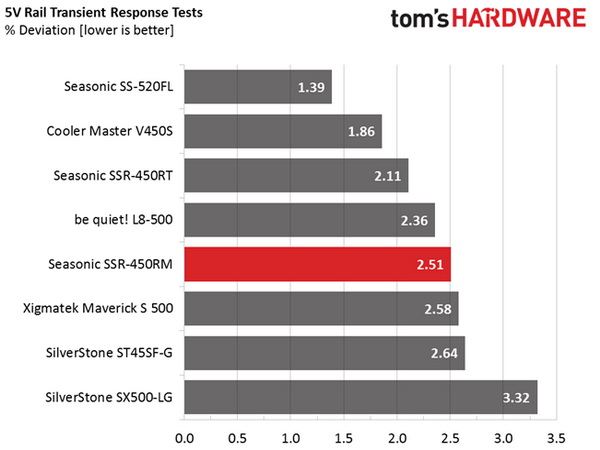


Although the G-450's capacity is a significant handicap for these tests, its +12V rail did pretty well and stayed close to one percent deviation. The 5V and 5VSB rails also performed well, while the 3.3V rail registered a mediocre performance. This was especially true in the second test, in which the voltage levels dropped below 3.2V when we applied the transient load.
Here are the oscilloscope screenshots we took during Advanced Transient Response Testing:
Transient Response At 20 Percent Load
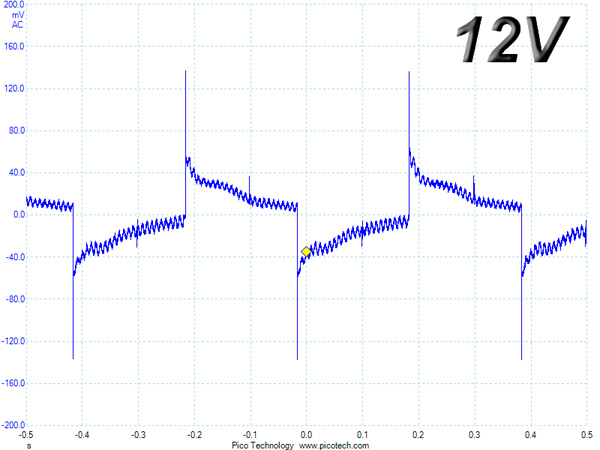

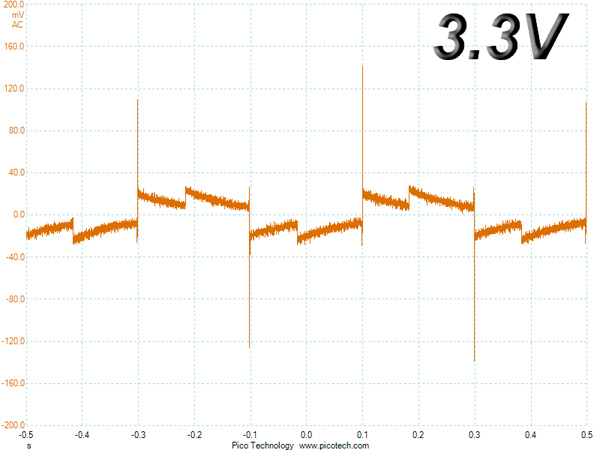
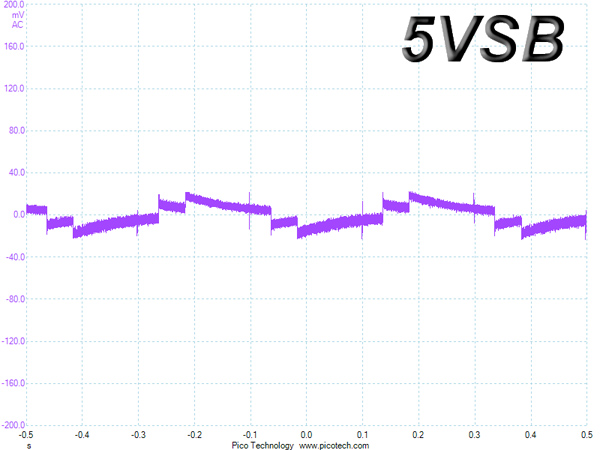
Transient Response At 50 Percent Load

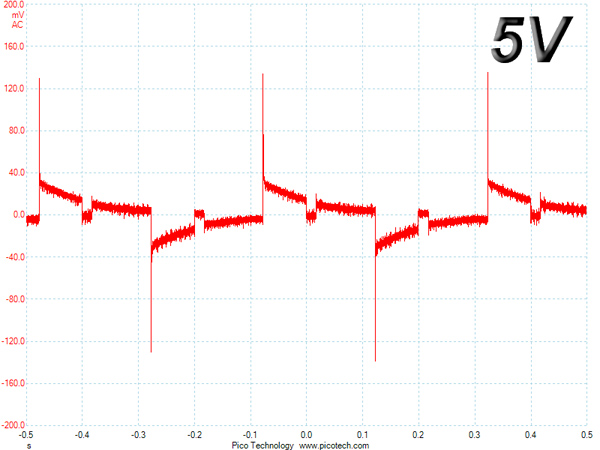
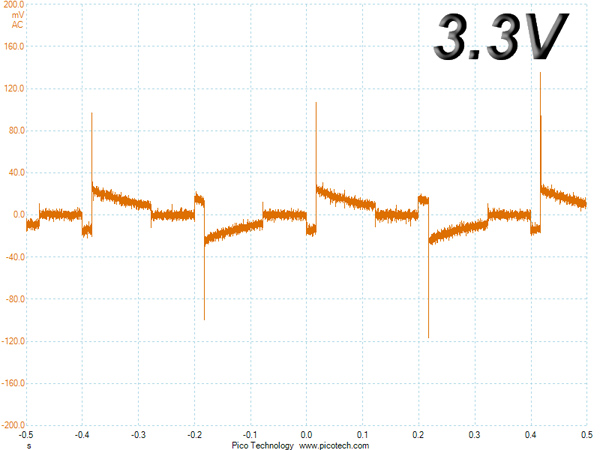
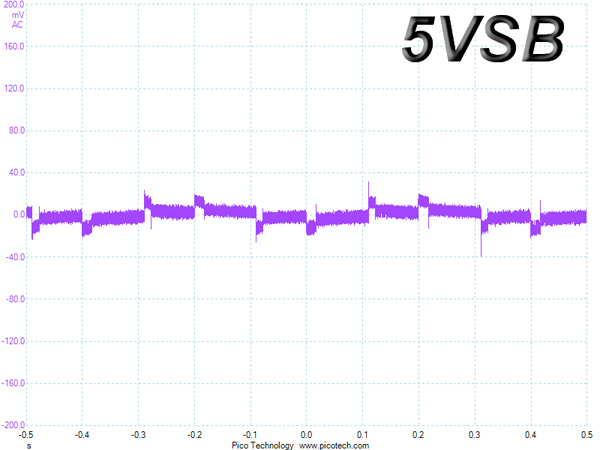
Turn-On Transient Tests
In the next set of tests, we measured the response of the PSU in simpler transient load scenarios, during its power-on phase.
For the first measurement, we turned off the PSU, dialed in the maximum current the 5VSB could output and switched on the PSU. In the second test, we dialed the maximum load the +12V could handle and started the PSU while it was in standby mode. In the last test, while the PSU was completely switched off (we cut off the power or switched it off by flipping the on/off switch), we dialed the maximum load the +12V rail could handle before switching on the PSU from the loader and restoring power. The ATX specification states that recorded spikes on all rails should not exceed 10 percent of their nominal values (+10 percent for 12V is 13.2V, and 5.5V for 5V).
Get Tom's Hardware's best news and in-depth reviews, straight to your inbox.
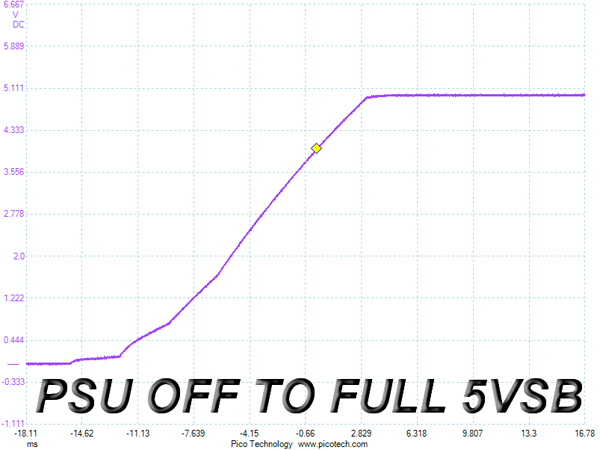


The performance of the 5VSB rail was great during the first two tests. The results of the third test weren't as satisfying; we noticed a period with increased ripple along with a wave right before the rail settled down to its nominal voltage.
Current page: Transient Response Tests
Prev Page Cross-Load Tests And Infrared Images Next Page Ripple Measurements
Aris Mpitziopoulos is a contributing editor at Tom's Hardware, covering PSUs.
-
InvalidError 0.4 ohm Rdson is not that bad for primary-side FETs where switching losses tend to be much worse than on-losses.Reply
Also, FETs with better on-resistance usually have larger gate charge, which means you end up needing more gate drive power to achieve the same switching performance. Saving 3W on full-load on-losses does not sound as good if it costs you 2W in gate drive regardless of load.
Using FETs with lower on-resistance does not necessarily improve overall efficiency by much. -
TechyInAZ Good read. I personally have the 550W version of that PSU and it works very well. Very quiet too, however my entire system doesn't go beyond 350W at max load.Reply
BTW...The 550W version is usually only $3-$5 more than the 450W. I've never seen the price change either, so it is a bit silly to buy the 450W version if the 550W is always only $5 more. -
Dunlop0078 I also have the 550watt version, its been going strong for about two years now its very quiet even under load I think I pull about 450watts or so when I have all my overclocks applied. It has been totally stable not a single problem with my PC or the psu since I bought it.Reply
However I think the price should be lowered a bit for the 550watt version because now it has to compete with the likes of the EVGA 550 G2 which is about the same price but it seems to perform a bit better and comes with a 10 year warranty. -
TechyInAZ Reply16760449 said:I also have the 550watt version, its been going strong for about two years now its very quiet even under load I think I pull about 450watts or so when I have all my overclocks applied. It has been totally stable not a single problem with my PC or the psu since I bought it.
However I think the price should be lowered a bit for the 550watt version because now it has to compete with the likes of the EVGA 550 G2 which is about the same price but it seems to perform a bit better and comes with a 10 year warranty.
10 year warranty!!?? I've been using EVGA graphics cards for years now, I think ill start buying EVGA PSUs now. :D -
Dunlop0078 Reply16760449 said:I also have the 550watt version, its been going strong for about two years now its very quiet even under load I think I pull about 450watts or so when I have all my overclocks applied. It has been totally stable not a single problem with my PC or the psu since I bought it.
However I think the price should be lowered a bit for the 550watt version because now it has to compete with the likes of the EVGA 550 G2 which is about the same price but it seems to perform a bit better and comes with a 10 year warranty.
10 year warranty!!?? I've been using EVGA graphics cards for years now, I think ill start buying EVGA PSUs now. :D
Actually im wrong on that its a 7 year warranty for the 550watt model (still very good in my opinion) the 750watt g2 and above have the 10 year. -
10tacle I know Seasonic is good and an OEM to PSUs for Corsair and whatnot, but I was an unlucky one. My 620W S12II crapped out on an older backup rig after about a year of light use, maybe 250 hours. Unfortunately I voided the 5-year warranty when I had to break the screw seal and open it to get a screw out that accidentally fell in (PC was unplugged when that happened). I figured I'd never need to worry about dealing with a warranty RMA anyway since in nearly 20 years of PC building I've never had one die early on me. WRONG.Reply -
InvalidError Reply
Murphy strikes again!16760681 said:I figured I'd never need to worry about dealing with a warranty RMA anyway since in nearly 20 years of PC building I've never had one die early on me. WRONG.
-
Blueberries This PSU isn't bad but I don't see why anyone would want to pay in the $70's for it when there are gold-- almost platinum rated Leadex PSUs for $80-$90.Reply
The build quality is what I've come to expect from SeaSonic. Very well built with mostly Nippon Chemi-Con capacitors. Rubycon is also a good brand, and I like to see Infineon MOSFETs in PSUs. This PSU should last forever but isn't very efficient compared to similarly-priced competition. -
turkey3_scratch Reply16760497 said:16760449 said:I also have the 550watt version, its been going strong for about two years now its very quiet even under load I think I pull about 450watts or so when I have all my overclocks applied. It has been totally stable not a single problem with my PC or the psu since I bought it.
However I think the price should be lowered a bit for the 550watt version because now it has to compete with the likes of the EVGA 550 G2 which is about the same price but it seems to perform a bit better and comes with a 10 year warranty.
10 year warranty!!?? I've been using EVGA graphics cards for years now, I think ill start buying EVGA PSUs now. :D
Yeah, aside from the fantastic quality, that was another reason I purchased the G2 over any other PSU. -
tsnor "... Seasonic doesn't use a fully modular design in its G series to keep production costs low. Of course, it would be nice if the company changed its strategy and went all-modular on its G-series models since many competing PSUs are, in fact, fully modular...."Reply
Or maybe they
(1) know that people will always use the permanent cables that power the MB
(2) know that two less connectors is a good thing for product reliability
(3) want to ship a product for people like me that prefer this configuration to a fully modular configuration